Photos: Kip Miller
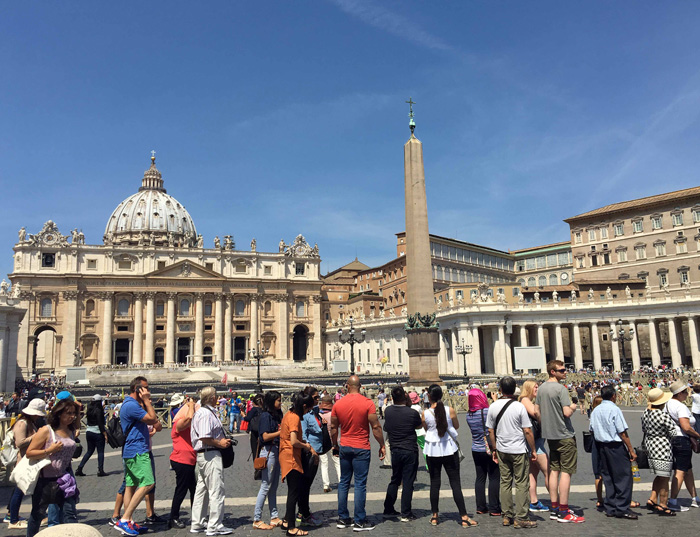
In Vatican City, St. Peter's Square is embraced by curving colonnades topped with 114 statues of saints. The huge obelisk in the center is the largest to ever leave Egypt.
Vatican City sprawls on 110 acres on the west side of the Tiber River,
enveloped in walls and linked to Castel Sant'Angelo, once Hadrian's mausoleum,
via an elevated walkway called the Pasetto Di Borgo. It officially became
the world's smallest sovereign state in 1929 and has been protected by
a tiny army of colorfully-clad soldiers known as the Swiss Guard since
1506. Our first visit to The Vatican was in 1969, when crowds were much
thinner and we were permitted to photograph the Sistine Chapel, but not
its galleries. Decades later, the Vatican experience is supposed to be
more camera-friendly, with opportunities to "beat-the-crowds"
on early morning tours. "We have to go again!" I implore my
husband. "We will appreciate it so much more now." And so we
book our Walks of Italy "Vatican Early Bird Tour" on-line, months
before arriving in Italy, planning to visit on the Tuesday after the completion
of our tour of Tuscany and Umbria. Kathy and Eric, our long-time traveling
friends, are as eager to explore the Vatican as we are.
It is 6:30 AM on a cloudless Tuesday and our taxi is waiting in front of the Ambasciatori Palace Hotel. "Ah, Il Vaticano!" exclaims the driver as he races through Rome's nearly empty streets and across the Tiber. "Eccoci qui (here we are)," he screeches to a halt opposite an octagonal coffee house near our designated rendezvous point. We have a few minutes to spare and peruse our guidebooks over cappuccinos and gooey chocolate croissants. "Do you think the Vatican has changed much since 1969?" I ask my husband. "We'll find out soon enough," he mutters, motioning to a "Walks of Italy" sign held by a tall, bespectacled guide. "Good morning, I am Gigi, your guide," he announces in impeccable English. "There will be about a dozen of us and we must all stay together. Always look for my little tour flag, which I will hold up high above the crowd." Gigi enumerates his credentials, which include a Ph.D. degree combining archaeology, art history and anthropology from the University of California in Merced. "How fortunate for us," Eric smiles. "The Vatican processes thousands of visitors on most days! It is the smallest and youngest country in Europe," Gigi explains. "When we go through the Sistine Chapel, no photos are permitted and no talking. We must respect the rules. After all, it is the spot where Michelangelo picked up a paintbrush for the very first time and the world has not been the same since!"
Gigi dives into a lengthy history of the Chapel, noting that its most recent fresco restoration was completed in 1994 with breathtaking results. Half an hour passes by and we are still standing in line. I am alarmed to see how much the crowd has multiplied. There are tour flags everywhere. So much for early bird tours! And then it dawns on me. Trump is in Rome on his first European trip and he and Melania are scheduled to visit the Pope tomorrow morning! "No wonder it's so crowded," I gripe. "They have crammed all the Wednesday tours into today's schedule because the Vatican will be closed to visitors tomorrow during the Trump visit!" "Can you believe our luck?" grumbles Kathy.
Finally the
doors open and we pass through security check. "We will begin in
the antiquities galleries. Here you will see a breathtaking array of many
the greatest sculptures from the Greek and Roman eras collected by the
early popes," notes Gigi. "During the Renaissance, many prominent
painters found inspiration in this immense collection." He reminds
us that The Vatican is the oldest institution in the world still in business.
It was here that Constantine built the original St. Peter's in the fourth
century above the very spot where the apostle was crucified upside down
and buried in 67 AD. At that time, a lot of marble from the Colosseum
was recycled. As you would expect, the galleries are packed with dizzying
array of statuary. I can barely decide which ones to focus on.
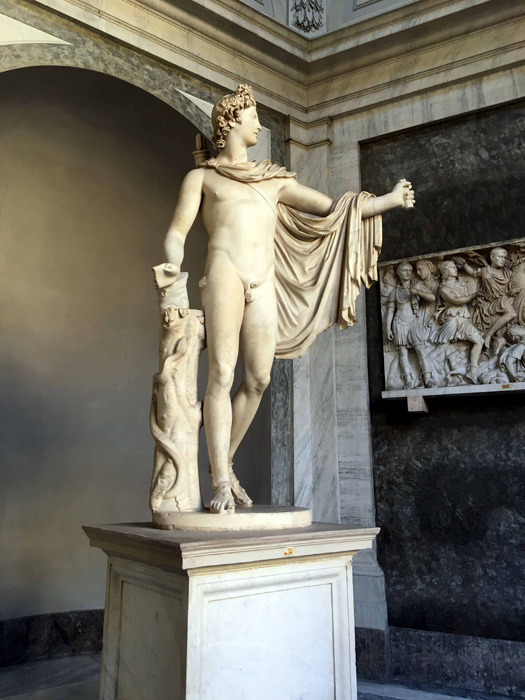
The Apollo Belvedere statue is considered an exceptional example of the classical
genre. Here Apollo has just released an arrow from his bow (sadly missing).
We pause by the Belvedere Torso in the Pio Clementino Museum. This unusual broken piece is reputedly a representation of the Greek hero Ajax, probably created by the Athenian sculptor Apollonius. "Here Ajax is on the verge of killing himself," explains Gigi. "It is one of the greatest treasures in the Vatican collection." Nearby, another masterpiece, the Apollo Belvedere statue, is universally considered a sublime specimen of the classical genre. I pause to admire it, marveling at how it seems to capture the very moment that Apollo releases an arrow from his bow (now missing).
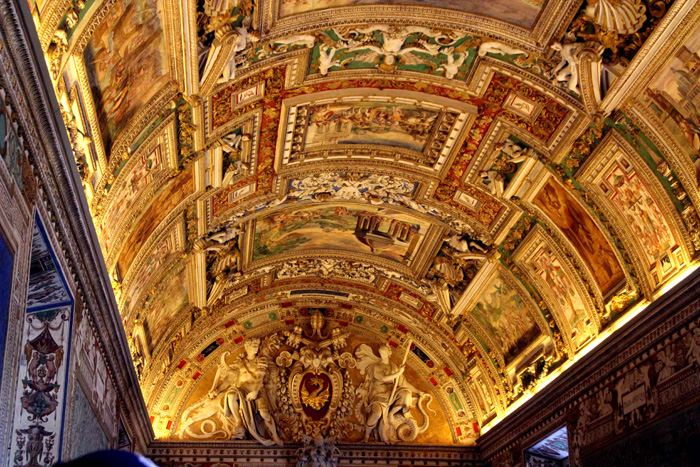
Gilded ceilings in the Gallery of Maps are embellished with mannerist paintings and stucco reliefs, blending nature, geography and religious themes in imaginative ways.
"We cannot possibly visit all seventeen entities that house the papal collections," apologizes Gigi. "The Vatican holdings are vast and diverse and they are spread throughout the Egyptian and Etruscan Museums, Raphael's Rooms, the Pinacoteca and the Borgia Apartment, to name just a handful of the spaces." "Why did the popes collect so much art?" one of our group asks Gigi. "My guess is that it was their way of building the church coffers, educating the masses and preserving the art for future generations." "That's a politically correct answer," mutters my husband. "Let us now stroll through the maps corridor and as we head to the Raphael Rooms," Gigi announces, hoisting his flag high in the air.
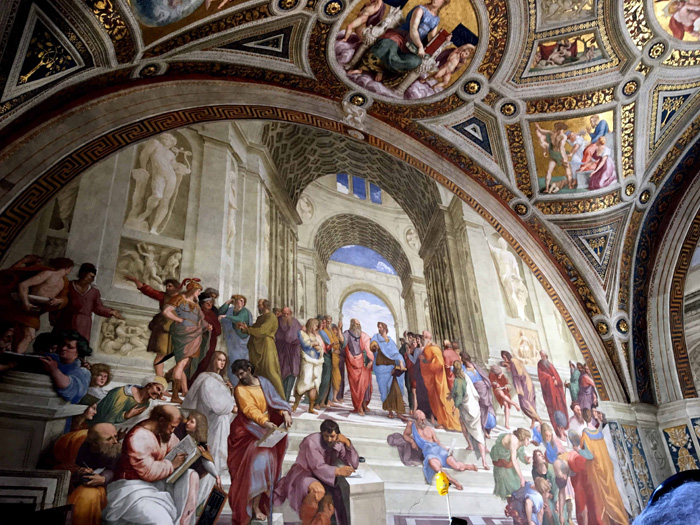
Raphael's masterpiece is his rendition of the School of Athens, a large fresco contrasting the theoretical world of Aristotle with the physical world of Plato.
Up until now the crowds in each section have been manageable, but when we reach the Raphael Rooms there is barely an inch to spare and people are packed liked sardines, holding cell phones high above their heads as they attempt to capture the images. "Raphael painted the frescoes in these rooms at the same time Michelangelo was propped up on a scaffolding inches from the ceiling he was painting in the Sistine Chapel," says Gigi. "He would often climb up next to Michelangelo after a day's work to see how he was progressing." I strain my neck above the crowd to gain a glimpse of these famous scenes. "Raphael's greatest work is his rendition of the School of Athens. It embodies the classical spirit of the Renaissance," Gigi raises his voice above the din. This fresco is about 25 feet wide and its theme is philosophy. At the very top are Plato and Aristotle, the former representing the theoretical, metaphysical world, the latter the observable, physical world. Other allegorical figures in the lower portion exemplify the diverse community of intellectuals who populated the classical era, from Heraclitus and Diogenes to Pythagoras and Euclid. "We have to be very grateful to Pope Julius II for what we see here," observes Gigi. "He was a great humanist and held classical learning in high esteem." He then points to a face with a black hat in the lower right corner: "This is Raphael. In Italy it is popular way of signing a painting."
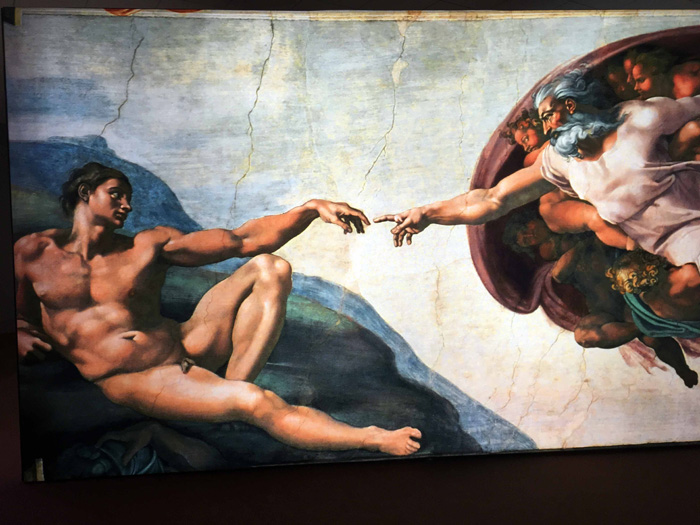
In the Sistine Chapel, Michelangelo's focal point is his fresco of the creation of mankind, with God about to give life to Adam by touching his finger. Photo from a pop-up gallery of the Sistine Chapel Frescoes at the Westfield Mall in Woodland Hills, CA, created by Westfield Global Entertainment.
We close in on the Sistine Chapel, the sacred space where cardinals meet
under lock and key each time they elect a new pope. I suddenly recall
that in 1969 we had it almost all to ourselves and even took a few photos.
Today it is standing room only. Several guards are continuously admonishing
the crowd to keep silent and put away their cameras. Nearly everyone is
staring at the ceiling, most notably at "The Creation of Adam."
Here, God is depicted as a wise old man supported by an entourage of angels.
He is about to touch a reclining Adam, thus giving him life. We turn our
gaze to an enormous scene painted on the wall behind the altar. It is
Michelangelo's interpretation of the "The Last Judgment," completed
four years after the ceiling. Jesus is shown floating above a mass of
humanity. Some lucky souls are rising up to heaven, but many others are
plunging into hell. "He was much inspired by Luca Signorelli's rendition
of the same scene in the cathedral at Orvieto, but he improved upon it,"
notes Gigi.
I find it hard to believe that Michelangelo had never held a paint brush until he began this assignment. But then the man was a genius, a prodigy from childhood on. The artistic leaders of Rome, including Raphael and Donato Bramante, the architect of the current basilica, were envious of Michelangelo's meteoric rise to fame and persuaded Pope Julius II to hire him, convinced that he would fail in his effort to paint. But Michelangelo's genius prevailed, and after four years, a masterpiece unlike any that had ever been seen was revealed to the public on All Saint's Day. "The pope wanted the figures to be retouched with gold," says Gigi. "He thought they looked too poor, but Michelangelo insisted that they be left alone." "Do you know how much they paid him?" asks Eric. "About 3,000 ducats," Gigi explains, "but out of that he had to pay for his brushes and paints. After the project's completion, he had a tough time readjusting his eyes to look downward." As we file out of the Chapel, Gigi erupts into a rakish grin: "By the way, Michelangelo never married and he lived to the ripe old age of 89. Raphael, on the other hand, was a real ladies man. He died at 37 of a French disease."
The Vatican
Museum is crisscrossed by endless winding staircases and corridors that
are the conduits to its 1400 rooms. We pass through several called "the
Closets of the Catholic Church," bursting with hundreds of humble
objects like oil lamps in every conceivable shape and even some menorahs.
I am startled to see a Hebrew prayer book dating from the ninth century,
surely one of the oldest surviving versions in the entire world. "The
Vatican Library has eight million books," boasts Gigi. "Many
are rare specimens that cannot not found anywhere else." Fatigue
is beginning to set in and I ask Gigi to find me a chair for a few minutes'
pause. He takes the rest of our group on an obligatory convoluted path
through several more passages and stairs. About ten minutes later they
miraculously reappear at the very spot where I am sitting. Even though
Gigi knows all the shortcuts, he is obliged to follow the prescribed route.
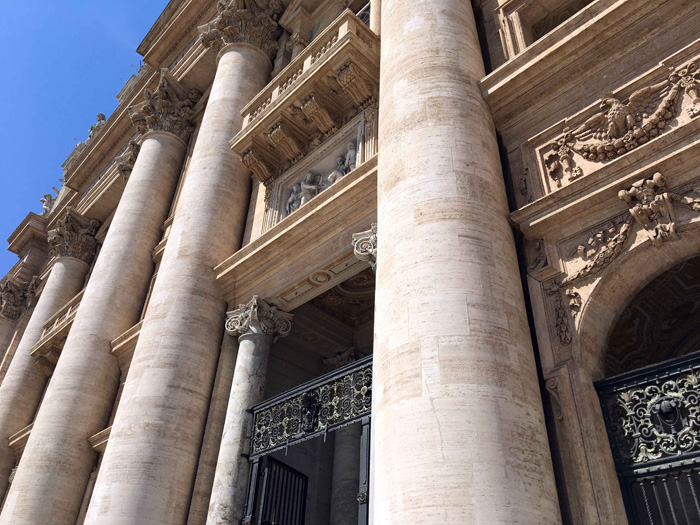
St. Peter's massive facade is fronted by the Pope's Balcony, the site of papal coronations and weekly public appearances.
We exit the museum and head toward the Basilica. St. Peter's Square stretches
to our left, an enormous elliptical esplanade designed by Gian Lorenzo
Bernini. It is framed by massive curving colonnades meant to resemble
outstretched arms reaching to embrace the public. Each of its 140 columns
is topped by a statue of a saint. In the middle are rows of chairs set
out for the faithful who come to hear and see Pope Francis on Wednesdays
and Sundays. An obelisk looms over the space, the largest to ever leave
Egypt. It was brought to Rome in 37 AD by the then emperor Caligula who
placed it in his garden. During Nero's reign it towered above a circus
spina and was only moved to its current location the middle of St. Peter's
Square in 1585. "Legend says that there was once a globe on top of
the obelisk filled with Julius Caesar's ashes, but when the obelisk was
moved to the square, workers opened it and found it empty and the globe
was replaced with a cross," notes Gigi with chuckle as we proceed
to enter the Basilica.
"The
original St. Peter's was constructed during Constantine's reign,"
Gigi reminds us. "It had four aisles and a central atrium with a
fountain. But by the middle of the 15th century it was in terrible shape
and literally crumbling." Some fifty years later, Pope Julius II
decided to have a brand new church built and Donato Bramante was appointed
as chief architect. "The new basilica, in the shape of a Greek cross,
would become the largest church ever built in the world," Gigi emphasizes.
Later, other architects got involved in the design, including Michelangelo
who took charge when he was 72 years old. He is credited for the creation
of its magnificent dome. "After Michelangelo's death, some changes
were made and the basilica was extended into the shape of a true Latin
cross," he explains.
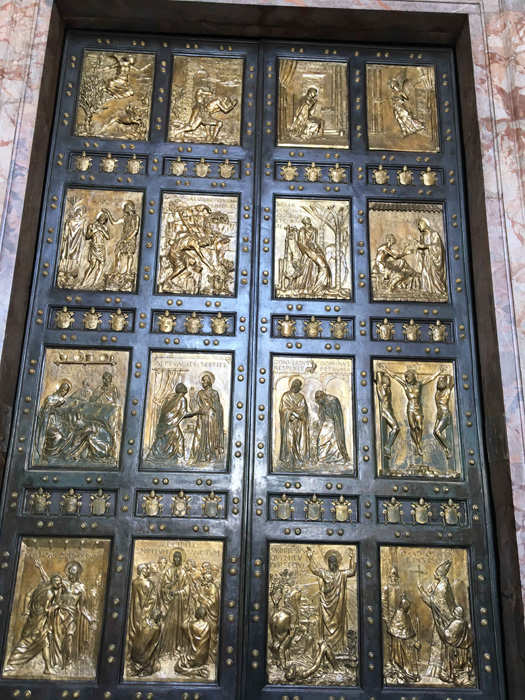
A small bronze door, the Porta Sancta, one of five entrances
to St. Peter's Basilica, is only opened during Jubilee Years.
There are no fewer than five entrances that lead to the welcoming narthex
area of St. Peter's. My eyes are immediately drawn to two huge equestrian
statues. "That's Charles the Great on the left," says Gigi,
"and the other is Emperor Constantine." The massive central
bronze door is the handiwork of the Florentine architect, Filarete. But
we more impressed by the smaller door on the right, the Porta Sancta,
which is only opened every 25 years during a Jubilee. As we go inside,
I notice that it is all bricked up.
Thousands
of tourists are visiting the Vatican complex today, and many of them are
roaming around the Basilica with space to spare, a testament to its enormous
size. "We are talking about a surface area of more than 15,000 square
feet," explains Gigi, "which can handle up to 60,000 people
at a time." "Amazing," says Kathy as she gazes up and around
in wonderment. St. Peter's is embellished with polychrome marble, mosaic
paintings, glittering gold, and magnificent sculptures, many created by
Bernini. The opulent central nave is covered by a coffered ceiling and
crowned by Michelangelo's majestic dome. Every inch is richly adorned,
a testament to the immense wealth of the church. "Look down at the
floors," says Gigi. "There are markers that show you how the
world's major churches compare in size."
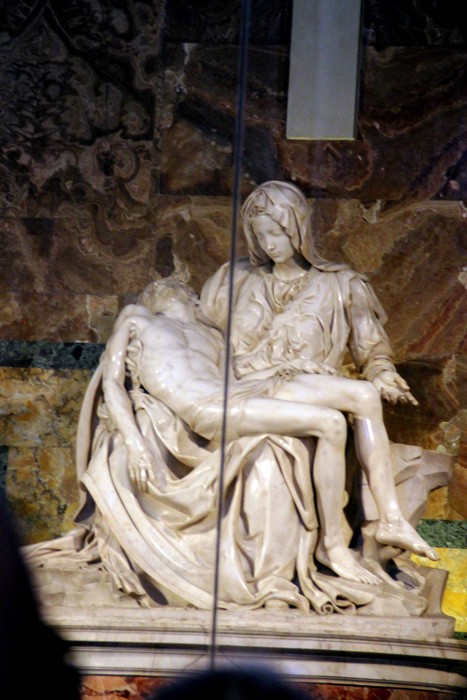
Michelangelo's Pietà, considered one his greatest masterpieces, is protected by bulletproof glass.
I turn to the right to catch a glimpse of Michelangelo's Pietà, today shielded by a bullet-proof glass enclosure that was built after a deranged tourist chipped away at the artist's delicate sculpture with a hammer in 1972, causing significant damage. I remember standing right next to it in 1969. Fortunately, its magic holds up even from afar: the Virgin seems to be at peace, having accepted her fate as she holds her son's lifeless body. "Michelangelo was only 24 when he carved The Pietà," I hear Gigi's voice behind me. "His immense talents became apparent when he was barely in his teens. It is the only sculpture that he ever signed."
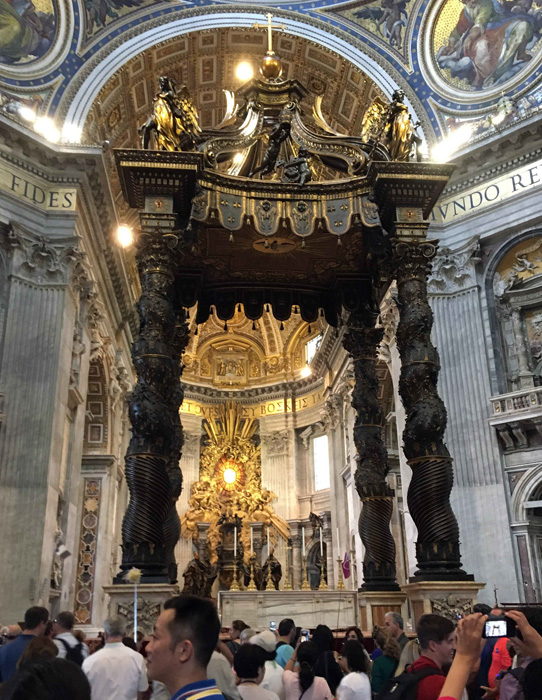
Gian Lorenzo Bernini's enormous 26-meter baldachin is an elaborate bronze canopy covering the papal altar.
We continue down the central nave to the baldachin, an enormous, bronze ceremonial canopy designed by Bernini that covers the papal altar. "The spiral columns of the baldachin are about 26 meters high. The bronze used here was cannibalized from sections of The Pantheon," Gigi reveals. He pauses by the altar where a burial crypt surrounded by a balustrade denotes the presumed location of St. Peter's grave. "So much history took place here and continues to be made even today," Gigi says with emphasis.
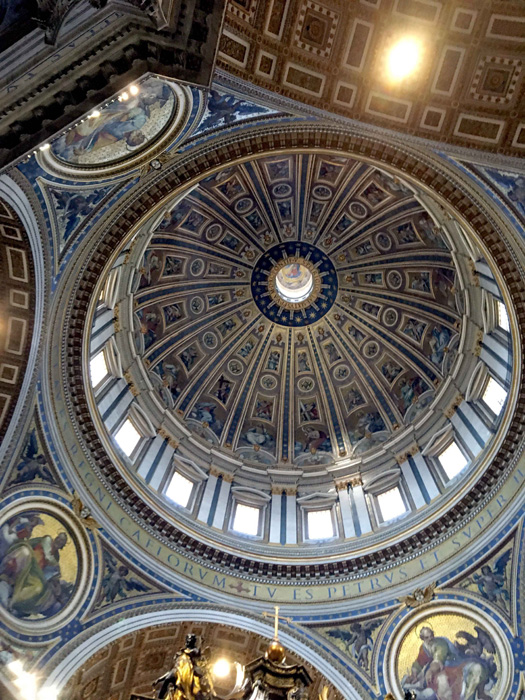
Michelangelo's glittering dome has a diameter of more than 42 meters. Those who
ascend to its viewing platform are rewarded with panoramic views of Rome.
All of us turn our gaze upwards, toward Michelangelo's glittering dome.
It has a diameter of more than 42 meters and is supported by four pillars.
Atop these pillars is a cylindrical drum with some 16 large rectangular
windows. The drum and windows support a ribbed vault. At the center of
the vault is an oculus under which hangs a huge lantern. "Those who
ascend the dome to its viewing platform will be rewarded with the most
spectacular views of Rome," Gigi announces, "but it's a challenging
climb."
I walk back slowly toward the narthex area, trying to digest this pulsing heart of the Catholic world. "It's a living history museum, I think you will agree," comments Gigi. There is so much more to explore, including the Museu Storico Artistico. But we are on sensory overload. "Next time you come you must visit the Vatican Grottoes," says Gigi in parting. "Here you will find the tombs and sarcophagi of many popes and fragments of the original basilica." "I have a final question," one of our group pipes up. "Will the former Pope Benedict also be buried here?" "Of course. He will be buried in the papal crypt," Gigi replies, "but his sarcophagus will not bear his papal name, just his birth name. He is the only pope in history ever to resign and, therefore, he's not permitted to leave the Vatican. They even melted down his papal ring and recast it for Pope Francis!"
The crowds
are much thinner outside as we stroll in the direction of Castel Sant'Angelo
and a crowded taxi stand. "Piazza di Spagna, per favore," I
tell the driver. It's time for a change of pace and Rome's upscale shopping
area is just the ticket. We are ravenous, but after two weeks in Italy,
all of us have had our fill of endless pasta and multi-course lunches
and are drawn to a small café advertising Greek salads. "Not
exactly the real thing," I comment as I dive into an oversized plate
piled high with juicy tomatoes, crisp lettuce and an Italian substitute
for feta. "Good enough," we decide as we down our ice cold Nastro
Azzurro beers.
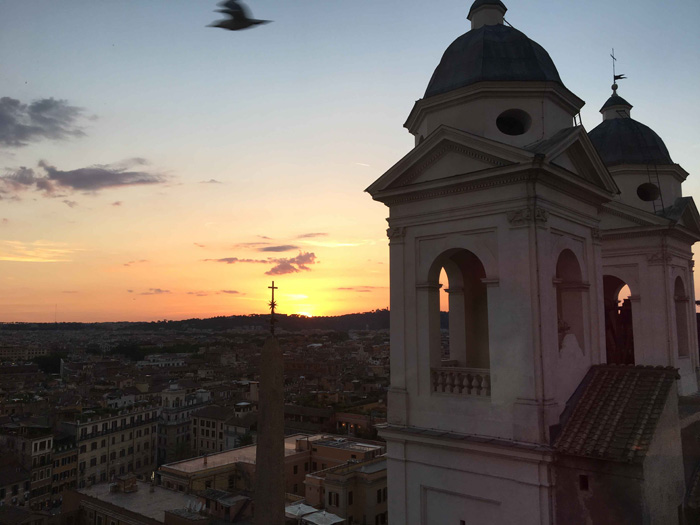
An orange sky with circling blackbirds adds drama to the vista from Imago, a Michelin-starred restaurant atop the Hassler Hotel.
In early evening, the four of us return to the Piazza area for dinner at Imago, a Michelin-starred restaurant atop the elegant Hassler Hotel. Its marbled lobby is distinguished by a bronze replica of the she-wolf of Rome suckling Romulus and Remus, a fitting metaphor for a dining experience at a prestigious Roman restaurant. We are early enough to land the best table in the house, next to wraparound windows overlooking the Spanish steps and beyond. "We have a real bird's eye view of all of Rome," smiles Kathy as she surveys an array of monuments ranging from Santa Maria Maggiore to the Villa Medici and Borghese Gardens. It's a unique dining experience, complete with formally-dressed wait staff who attend to our every need. A lineup of Japanese-Italian fusion dishes begins with a tangy amuse bouche of quail eggs and an amazing bread course, followed by nuanced entrees featuring delicate sea scallops, rigatoni tossed with mackerel, sake-glazed black cod and piquant grilled pigeon with lentils, all the handiwork of Neapolitan Chef Francesco Apreda who trained in Japan. "Tell the chef he deserves 'two' Michelin stars!" says a happy Eric to our waiter. Minutes later Apreda arrives at our table. "Grazie mille!" he beams. We linger over house-made sorbets and stare out the windows, mesmerized by an orange-streaked sky complete with circling blackbirds. As we leave, I approach the glass to peruse Rome's darkening skyline. In the distance I can make out St. Peter's Dome glittering brightly on the horizon.
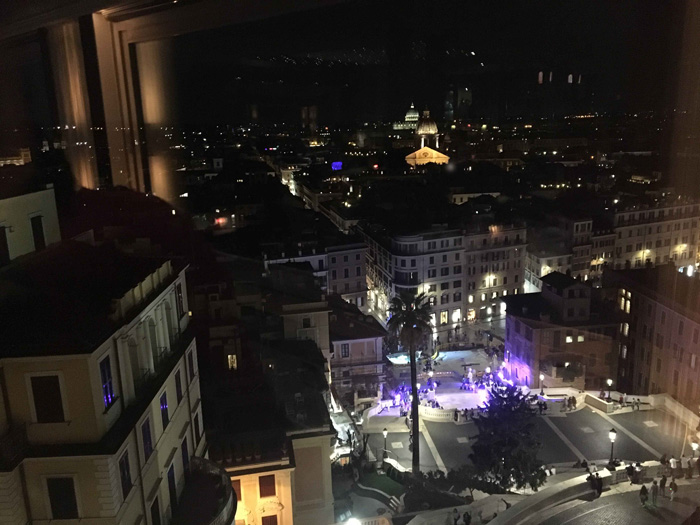
As night falls, the view from Imago is illuminated by Rome's twinkling lights, including St. Peter's Dome, visible on the horizon.
It's our last day in Rome. We head out mid-morning to visit the Quirinale
Palazio Museum where a Caravaggio exhibition has garnered rave reviews.
Traffic is barely moving and the owner of a ceramics shop that we stop
to visit never arrives to open up. "Something must be going on,"
says Eric. "Of course, it's Wednesday and Trump is here," I
remark in a flash of recall. "I bet he has already left the Vatican
and is now heading to the presidential palace right next to the Quirinale!"
And sure enough the street near the museum is closed off and a boisterous
three-deep crowd is lined up along the curb. Minutes later a motorcade
with a couple of dozen honking police cars and a limousine draped in an
American flag sweeps by. "That's the second time Trump has messed
with our itinerary," Kathy whines. "Never mind," I sigh,
"we are in Rome and it's a beautiful day." Hours later as I
peruse the news on my smart phone, I spot a photo of Trump and Melania
in a designer black hat standing next to Pope Francis. The Pope's dour
expression matches Melania's, as if both can hardly wait for the visit
to be over!
